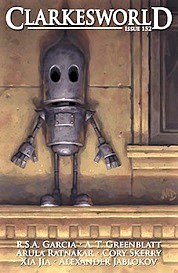“Tick-Tock” by Xia Jia
Reviewed by Victoria Silverwolf
All the tales in the latest issue of Neil Clarke’s long-running publication are science fiction, each one set in a future with highly advanced technology. The magazine whets the appetite with three original short stories, then serves up three novelettes as main courses, two of them new.
“Tick-Tock” by Xia Jia (translated from Chinese by Emily Jin) takes place in an overcrowded future world where people spend their waking hours in cramped living quarters and workplaces, and escape into programmed dreams while asleep. The avatar created by the programmer is a conscious being, imagining itself to be an actor taking on various roles in the dreams. The story shifts point of view between the programmer, the avatar, and the characters portrayed. These different levels of reality come together when the avatar confronts the programmer.
The theme of simulated realities is a familiar one in science fiction, and the author spends a little too much time introducing the concept to the reader. The most interesting thing about this story is its unusual narrative style, frequently changing from third person to second person to first person. Praise should go to the translator for rendering it into smooth and readable English.
The narrator of “Move Forward, Disappear, Transcend” by A. T. Greenblatt is a woman well over two hundred years old. Much of her body consists of technological enhancements that maintain her health. Many younger persons have completely artificial bodies. Compared to them, the woman is an old-fashioned relic. Because she refuses to abandon her entire body, she faces the prospect of her friends and family becoming nearly ageless, while she remains mortal.
The story vividly portrays the disorienting effect of rapidly changing technology, as well as the inevitability of losing loved ones to time. Its speculative content is imaginative and convincing, making this strange future seem real.
Drastic changes in the human body also appear in “Empress in Glass” by Cory Skerry. The title character is a media star, her skin removed and replaced with a transparent substance. Flashbacks depict her tragic life as a child, and reveal the reasons for her plan to undergo an even more bizarre transformation.
This horror story offers a dark look into the mind of a seriously disturbed woman. The images portrayed are striking, but many will find them very unpleasant.
“Insaan Hain, Farishte Nahin” by Arula Ratnakar deals with a project to copy the memories of a human being, and transfer them into an artificial intelligence aboard a small probe sent to Alpha Centauri. The AI is supposed to be in stasis until it arrives. An attack on the designer of the technology involved, whose memories are the ones copied, causes the AI to waken. The story leaps back and forth in time, and changes point of view from the designer and her family to the AI, leading up to a final confrontation.
The author creates a complicated future with fully developed characters, making the reader care about them, whether they are people or programs. Although mostly written in a sophisticated literary style, the story contains long sections of exposition in the form of conversation between the characters, which seem clumsy compared to the rest of the narration.
“The Sun from Both Sides” by R.S.A. Garcia is the longest piece in the magazine, and consists of two parts that are almost separate stories. In the first half, slavers capture a man while he is on a journey to town from his rural home. His wife sets out to rescue him. The setting seems, at first, to be either the past or the typical low-tech world of heroic fantasy. It eventually becomes clear, however, that this is a future universe of starships and numerous inhabited planets. The woman was a deadly warrior, skilled with advanced weapons, before she came to this peaceful world and married her husband. With the help of an artificial intelligence, she destroys the slavers and frees their prisoners.
The second half of the story focuses on the man. For the first time, we learn the names of the characters. Exiled from his own planet because of his attempt to free the commoners from the tyranny of the ruling class, the man found happiness with his wife on a new world. Their joy is shattered when an emissary from his former home compels him to return. In order to save his wife from the wrath of the slavers she defeated, he must make repairs to the vast, living, alien structure that allows the rulers to oppress their people.
Although full of science fiction concepts, the story has a plot with the feeling of a fairy tale, as Good battles Evil. The author offers a complex, multilayered space opera with a richly imagined background. The presence of major characters without names in the first part of the story is disconcerting. That half also lacks suspense, because the woman is so powerful a fighter. The second part makes up for these flaws, but contains so many exotic details that it is often difficult to follow.
Victoria Silverwolf also read the reprinted story, but will remain silent about it.
 Clarkesworld
Clarkesworld